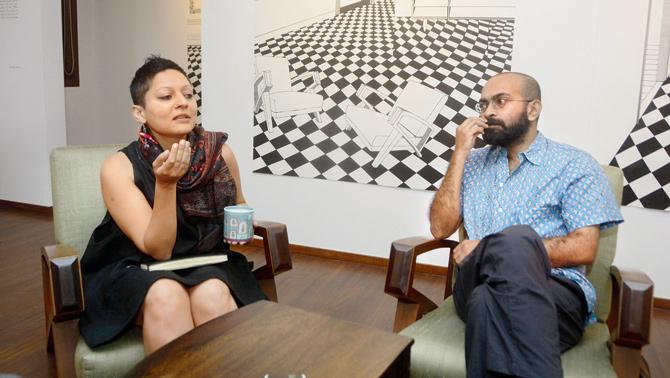Sketchbooks are both thrilling and intimidating — Nityan Unnikrishnan and Vishwa Shroff tell us why they love drawings


Vishwa Shroff and Nityan Unnikrishnan at Tarq, where Shroff's show Drawn Spaces is on view. Pic/Bipin Kokate.
ADVERTISEMENT
The parallels between Nityan Unnikrishnan and Vishwa Shroff begin at their heels. The two artists are eyeing each other's Birkenstock sandals as we settle down at Tarq, Colaba. In their shy ways, they laugh about the criticism that has been meted out to their sartorial choices.
New Delhi-based Unnikrishnan (his age: "I like the sound of 50") and Tokyo-based Shroff ("Can I be 40, please?") are in town for their shows, which opened on Thursday. Unnikrishnan's Wood from Ships, ongoing at Chatterjee and Lal, is a series of portraits and landscapes. Kai Freise writes in his essay on the show that the latter are "a series of 'danse macabres' of humanity going to hell. And doing it in a toxic landscape studded with monuments – Mughal and modernist from Akbar's Fatehpur Sikri to Shivnath Prasad's brutalist solids." At Tarq, surrounded by Shroff's drawings in Drawn Space, Unnikrishnan remarks, "Kai will be interested in seeing this."
Unnikrishnan and Shroff may seem like they are cut from the same cloth; however, if you love drawing, you may like to consider their very different approaches to the practice. Unnikrishnan's dreamy "ensemble scenes" are offset by Shroff's precise draughtsmanship; where Unnikrishnan's works teem with characters, Shroff lets her de-peopled spaces to do all the talking.
Building forms
Drawn Space, curated by Charlie Levine and Shroff's first solo in the country, brings together four series of works that explore spaces and everyday objects, otherwise considered banal. "I consider how architecture can itself become an archive of what has gone through it and the marks left behind – like wine spill on a carpet," she says. Transitions, for instance, is a series of drawings based on the floors at the Victoria and Albert Museum (the V&A), London, where Shroff had done residencies at. Heavily patterned and geometric, the missing tiles and gaping voids tell a story of the famous building. "The V&A was constructed over time; it was refurbished while being constantly in use and several markings on it tell that story," she says.
The War Room (2016) by Nityan Unnikrishnan. Pic/Chatterjee And Lal
Over at Chatterjee and Lal, Wood from Ships has visual references to monuments, elements of modern urbanscapes and even, cheekily, Antilla, the Mukesh Ambani's unmissable tower. While Unnikrishnan smiles knowingly but not quite acceding to it, he says that the tension between the rural and the urban is something that he cannot help. "While I don't follow architecture, my interest in it definitely has something to do with my practice as a potter and design school. Architecture is a good reflection of our history, a marker of our 'progress'," he says.
Unnikrishnan's show, his fourth at Chatterjee and Lal, comes across as more painterly than his previous ones. It's his first brush with canvas, khadi in specific. He had gone through about 20 samples of khadi before settling on those he wanted to use. Unnikrishnan says, "But I have hardly had any break in drawing. I still wake up every day and go to the studio to draw. I could keep drawing till I am sick of it."
Sketchbook diaries
Both admit that through art school, be it MS University in Baroda or the National Institute of Design (NID), a sketchbook is a pretty big deal. "My first sketch was something I made in a diary – those kinds with dates – soon after I realised that I wasn't going to pass a single paper of BSc Physics. When I went to NID, I saw people carrying these beautiful sketchbooks… I don't think sketchbooks are 'private'; I don't think they are meant for public consumption. They just happen to be there, in your bag," says a mirthful Unnikrishnan.
Shroff, on the other hand, says that she had lived inside her sketchbooks for so long that getting out of them was the challenge. She says, "I think that my sketchbook shouldn't be seen and that it's personal; when people ask me to show it to them, I say, 'Go ahead but it's brain vomit.'"
 Subscribe today by clicking the link and stay updated with the latest news!" Click here!
Subscribe today by clicking the link and stay updated with the latest news!" Click here!






